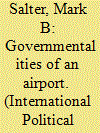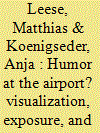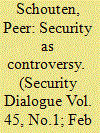|
|
|
Sort Order |
|
|
|
Items / Page
|
|
|
|
|
|
|
| Srl | Item |
| 1 |
ID:
155148


|
|
|
|
|
| Summary/Abstract |
This paper provides a detailed study of the liquid bomb plot from 2006, focusing on the ways in which the plot was constituted as “an event unlike others” (Adey, Anderson, and Lobo Guerrero 2011, 340). Engaging with a critical body of scholarship that examines how events are assembled and governed as emergencies, disasters, or catastrophes, the paper explores two sets of questions. First, the paper engages with the temporal dimension of the event, asking how the liquid bomb plot was mediated as a particularly risky event that required immediate action. Second, the paper focuses on the spatial dimension of the event and asks how the plot also threatened a seemingly interconnected system of global airline movements and a mobile form of life. Drawing on Cowen’s (2010) analysis of the “seam space,” I am particularly interested in developments of reform and experimentation at the airport and in how newly emerging technologies are targeted at keeping airports both secure and open. Ultimately, by examining the liquid bomb plot “in the middle of events” (Barry 2006, 244), the paper goes beyond an understanding of the security event as something that happens abruptly and by surprise, and sheds light on the ongoing work that is involved in constituting and governing events.
|
|
|
|
|
|
|
|
|
|
|
|
|
|
|
|
| 2 |
ID:
077541


|
|
|
|
|
| Publication |
2007.
|
| Summary/Abstract |
Airports are barometers of the balance between mobility and security sought by governments, industry, and the traveling public. This article examines this dynamic at a Canadian international airport, evaluating the legal and practical elements of the policing of movement with this crucial site of politics. Using two under-studied concepts from Foucault, the heterotopia and the confessionary complex, it is illustrated how contemporary aviation security arrangements are dependent on both the exceptional nature of the airport and the predisposition of citizens to confess in the face of agents of the state
|
|
|
|
|
|
|
|
|
|
|
|
|
|
|
|
| 3 |
ID:
137614


|
|
|
|
|
| Summary/Abstract |
With the emergence of aviation as a target for terrorism and serious crime in the 1970s, the affective dimension of airport security changed drastically and is now carefully engineered as a zone of earnest and solemn protocol. Against a backdrop of bombings and hijackings, airport security today enacts a “no bullshit” approach to the “war on terror.” Humor has essentially been banned from screening operations. From signs reading “No bomb jokes, please,” to drastic consequences in the case of non-compliance, security appears as something that is not to be fooled around with. Against this background, this paper builds on ethnographic fieldwork at Hamburg airport during the German trial run with body scanners in 2011. During the time of observation, we found a surprising amount of reciprocal laughter and joking. We argue that this can be conceptualized as an attempt to break open a space for laughter, momentarily abandoning protocol in order to deal with issues of visualization, exposure, and shame which arise from the new focus on the fleshly anatomical body.
|
|
|
|
|
|
|
|
|
|
|
|
|
|
|
|
| 4 |
ID:
140513


|
|
|
|
|
| Summary/Abstract |
What concepts such as ‘security’ and ‘privacy’ mean in practice is not merely a matter of policy choices or value concepts, but is inherently tied up with the socio-material and technological arrangement of the practices in which they come to matter. In this article, one trajectory in the implementation of a security regime into the sociotechnical arrangement of airport security checking is reconstructed. During this trajectory, gradual modifications or ‘translations’ are performed on what are initially defined as the privacy and security problems. The notion of translation is used to capture the modifications that concepts undergo between different stages of the process: the initial security problem shifts, transforms and comes to be aligned with several other interests and values. We articulate how such translations take place in the material realm, where seemingly technical and natural-scientific givens take part in the negotiations. On the one hand, these negotiations may produce technologies that perform social inequalities. On the other hand, it is in this material realm that translations of problem definitions appear as simply technical issues, exempted from democratic governance. The forms of privacy and security that emerge in the end are thus specific versions with specific social effects, which do not follow in an obvious way from the generic, initial concepts. By focusing on problem definitions and their translations at various stages of the development, we explain how it is possible for potentially stigmatizing and privacy-encroaching effects to occur, even though the security technologies were introduced exactly to preclude those effects.
|
|
|
|
|
|
|
|
|
|
|
|
|
|
|
|
| 5 |
ID:
127802


|
|
|
|
|
| Publication |
2014.
|
| Summary/Abstract |
Critical approaches to security have come to define themselves against mainstream security studies by not a priori assuming what security is, but rather taking it as an 'essentially contested concept'. Yet, as evidenced by the way in which recent 'turns' in the field have played out in the debate around airport security, ontological assumptions about security tend to restrict the scope of empirical analysis, with airport security being studied as, for instance, either discourse or practice. This article aims to propose an alternative methodological approach to security by studying security as controversy. Studying security as controversy means refraining from making a priori assumptions about the ontology of (in)security, instead considering it as itself at stake in - and hence the outcome of - security governance efforts. The article elaborates on this approach by drawing on core insights from actor-network theory, a conceptual and methodological toolkit that allows, as I show, a focus on how security actors perform security by enrolling, assembling and translating heterogeneous elements into stable assemblages that can be presented as definitive security solutions or threats. The article illustrates this approach through a look at the case of airport security at Amsterdam Airport in the aftermath of the 2009 Christmas terrorist attempt.
|
|
|
|
|
|
|
|
|
|
|
|
|
|
|
|
| 6 |
ID:
138774


|
|
|
|
|
| Summary/Abstract |
Much of the discourse surrounding counterterrorism centers on the inevitability of displacement, or the substitution of another form of terrorist attack in place of the one that has been thwarted. Yet a longstanding tradition of research in situational crime prevention finds that displacement is far from inevitable, and often depends crucially on the specific features of the incidents in question. In fact, crime prevention efforts are often followed by a “diffusion of benefits” (i.e., crime reductions) to incidents, groups, or locations that were not the intended target of the intervention. The current study examines various forms of displacement and diffusion in response to airport metal detectors among terrorist groups that had been involved in the perpetration of aviation attacks prior to their implementation. Using data from the Global Terrorism Database, the findings from interrupted time series models suggest a complex set of displacement and diffusion effects with respect to alternative attack modes, target types, and weapon usage.
|
|
|
|
|
|
|
|
|
|
|
|
|
|
|
|
| 7 |
ID:
105994


|
|
|
|
|
| Publication |
2011.
|
| Summary/Abstract |
A key problem for counterterrorism is how large numbers of individuals can be screened most efficiently to discover terrorists. This question arises at security checkpoints of all kinds, from roadblocks to airline security counters. Some argue that certain categories of individuals, for instance, young Muslim men in the airline context, should be screened more heavily than others. Others deride this as racial profiling, and argue that any such scheme would be easily evaded. I examine a model of searching for terrorists among a population divided into categories that vary in their potential reliability or ease of recruitment as agents of terrorist attacks. The equilibria in the model feature profiling, in that different categories are searched with different intensities. Practical difficulties in implementing a rational profiling scheme are discussed.
|
|
|
|
|
|
|
|
|
|
|
|
|
|
|
|
| 8 |
ID:
052509


|
|
|
|
|
| Publication |
2003.
|
| Summary/Abstract |
Hitherto, political science has failed to answer a rather simple question: Why do some states provide high levels of airport security, while others fail to do so? Drawing upon a rational choice institutionalist framework, we compare airport security regimes in the US and Europe (in particular Germany) and show that the performance gap before September 11 can be largely attributed to institutional factors. In the US, responsibility was assigned to airlines, whose cost-cutting efforts resulted in lax controls. In Germany, the government shielded the provision of airport security from market pressures. We claim that delegation of responsibility for airport security to the government is a necessary, yet not a sufficient condition for a high security performance. Systems in which responsibility lies with private airlines are doomed to fail, since private markets are ill-equipped to provide a high security performance. While airlines have a long-term interest in safeguarding civil aviation, there exists both a time inconsistency and a collective cost problem that prevents sufficient investment in security in the short run. Thus, US policy-makers are well advised to resist the growing pressures for re-privatization and cost-cutting as well as to eliminate remaining flaws in the current federalized system.
|
|
|
|
|
|
|
|
|
|
|
|
|
|
|
|
|
|
|
|
|